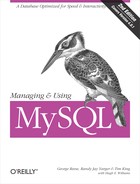Cursors
Cursors represent
SQL statements and their results. The
connection object provides your application with a cursor via the
cursor( )
method:
cursor = conn.cursor( );
This cursor is the center of your Python database access. Through the
execute(
)
method, you send SQL to
the database and process any results. The simplest form of database
access is, of course, a simple insert:
conn = MySQLdb.connect(host='carthage', user='test', passwd='test', db='test'),
cursor = conn.cursor( );
cursor.execute("INSERT INTO test (test_id, test_char) VALUES (1, 'test')");
print "Affected rows: ", cursor.rowcount;In this example, the application inserts a new row into the database using the cursor generated by the MySQL connection. It then verifies the insert by printing out the number of rows affected. For inserts, this value should always be 1.
Query processing is a little more complex.
Again, you use the execute( ) method to send SQL
to the database. Instead of checking the affected rows, however, you
grab the results from the cursor using one of many fetch methods.
Example 10-1 shows a Python program processing a
simple query.
import MySQLdb;
connection = None;
try:
connection = MySQLdb.connect(host="carthage", user="user",
passwd="pass", db="test");
cursor = connection.cursor( );
cursor.execute("SELECT test_id, test_val FROM test ORDER BY test_id");
for row in cursor.fetchall( ):
print "Key: ", row[0];
print "Value: ", row[1];
connection.close( );
except:
if connection:
connection.close( );The cursor object actually provides several fetch methods:
fetchone(
)
,
fetchmany(
)
,
and fetchall(
)
. For
each of these methods, a
row
is represented by a Python tuple. In Example 10-1,
the fetchall( ) method fetches all the results
from the query into a list of Python tuples. This method, like all
the fetch methods, will throw an exception if the SQL was not a
query.
Of course, fetching all the rows at once can be inefficient for large
result sets. You can instead fetch each row one by one by using the
fetchone( ) method. The fetchone(
) method returns a single row as a tuple where each element
represents a column in the returned row. If you have already fetched
all the rows of the result set, fetchone( ) will
return None.
The final fetch method, fetchmany( ), is middle
ground between fetchone( ) and fetchall(
). It enables an application to fetch a predefined number
of rows at once. You can either pass in the number of rows you wish
to see or rely on the value of cursor.arraysize to
provide a default value.
